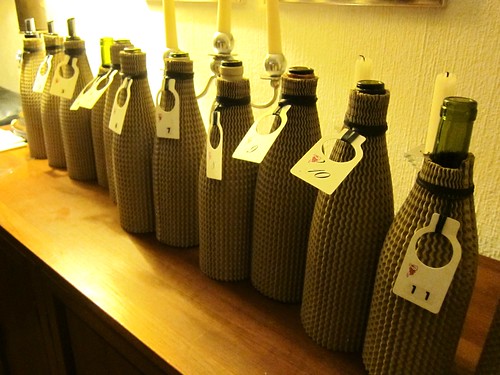
Last thursday we were about 10 wine-buddies gathering at our generous host Nick‘s home for a blind-tasting of red Rhône wines. This time there were absolutely no limits as all reds from all-over the Rhône-region were permitted, drastically differentiating it from our last tasting at Nick’s when only Southern Rhône reds were allowed, as well as from the last blind tasting at my place where boundaries were set by the Syrah varietal, originally stemming from that area but now being planted all over Planet Wine.
This means that each of the 12 bottles we popped that night could be anything from Côte-Rôtie and Hermitage to Côtes du Ventoux and Châteauneuf-Du-Pape, hence also mixing single-varietal wines with those that represent cuvées. As you can see, with each blind-tasting we are slowly encircling what both Rhône and Syrah have to offer. Are we gonna grasp the essence of it tonight? Dream on, dreamer.. Read the rest of this entry »
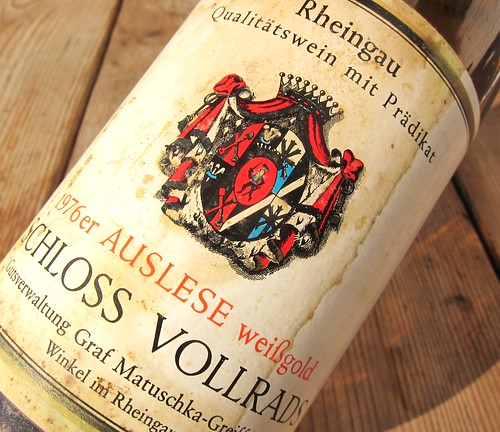
Hier hätten wir wieder eine Flasche aus der Reihe Alte Schinken aus Hammer-Jahrgängen. Obwohl: vielleicht war 1976 auch das 2003 der Siebziger, so heiß war es da laut Überlieferungen, und deswegen vielleicht nur ein ultra-reifer Jahrgang und nix für die Ewigkeit? Nun gut: Wir werden’s rausfinden, denn früher oder später muss die Flasche eh weg, und sei es in den Ausguß. Vom Namen her eigentlich nicht von schlechten Eltern: Schloß Vollrads gehörte damals noch zum Rheingauer Hochadel und Auslese weißgold klingt für meine Begriffe auch deutlich klangvoller als etwa gelbgold oder silber. Read the rest of this entry »
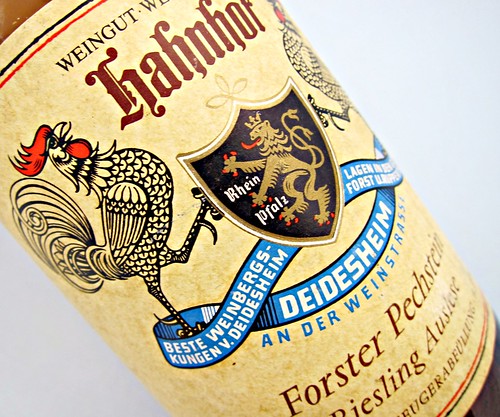
Eine “No-name” Flasche die über Ebay für wenig Geld erstanden wurde. Kaufargumente waren das heisse Jahr 1976, die tolle Lage Pechstein und die schiere Neugier. “No-name” auch, weil es das Weingut meines Wissens heute nicht mehr gibt.
Nun ist der Wein im Glas: Read the rest of this entry »
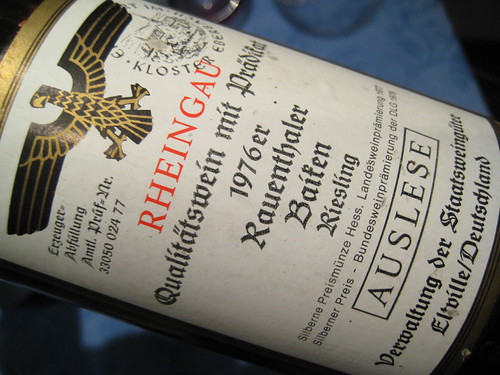
Again a nice Christmas Wine. This old Riesling from Hessische Staatsweingüter (State-owned wineries of Rheingau) showed of course strong signs of maturity but did not at all seem old. Golden colour, aromatic nose, tasty body with bitter orange notes and a certain freshness, slight acidity.
buy flagyl online www.conci.com/wp-content/languages/new/online/flagyl.html no prescription
Perfect with cheese!
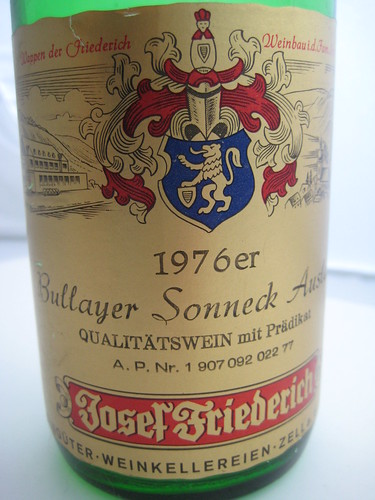
This is my next aged Riesling-bottle, this time from the very very good 1976 vintage. It’s an eBay bottle from some quite totally unknown estate in the Mosel region, since I striclty found nothing about it on the net.
Therefore, and also because lots of people don’t appreciate aged white, I got it for very little money.
It is an Auslese which is the third highest Prädikat and comes before the well-known sweet wine Prädikate such as Trockenbeerenauslese or Eiswein.
buy valtrex online pavg.net/wp-content/languages/new/where/valtrex.html no prescription
Auslese means that only the best grapes in the vineyard are selected and the mustweight should be at least 95 Oechsle degrees.
buy cytotec online pavg.net/wp-content/languages/new/where/cytotec.html no prescription
Most generally a Auslese comes with relatively low alcohol and rather high residual sugar.
buy levaquin online pavg.net/wp-content/languages/new/where/levaquin.html no prescription
Nowadays the trend is that there are more and more “trockene Auslesen” being made, which means dry Auslesen, but for a 1970’s wine one can almost be sure it is a nondry wine.
We had it at the end of a dinner as a final bottle without any food accompanying it. The wine had golden colour with an amber hue. In the nose some Edelfirne of course reminding wax and honey as well as some orange zest. On the palate it was at first striking how low the alcohol level was. There was no indication on the label about the alcohol (at that time it wasn’t mandatory) but it must have already been low and by now it had nearly completely disappeared. My guess would be something like 4 to 6 %, and it was such that one could have the impression to taste grapejuice actually. Nevertheless it had a long finish with a fresh minty note. All in all the wine was still in very good shape regarding oxidation and cork, but lacked a bit of structure as it seemed a bit watery sometimes and of course was short of alcohol. I think it would be best drunk as a refreshing and light starter drink before a dinner.
86 points

Do you believe in the ageing of dry white wines? I have always been very sceptical about it. Generally there are only a few (non-sweet) white wines which are known to have a good ageing potential. These are Chablis (Chardonnay) or other white Burgundies like Montrachet’s for example, and of course Rieslings’. If a Riesling has an optimal balance between fruitiness/sweetness and acidity it can pracitcally age forever and if it has as an extra, minerality and complexity, it might become a fabulous treasure! Well this is at least the theory.
Of course, as a German I have so far mostly been confronted to old Rieslings. And practically when I think of them, I have an image on my mind of some brown liquid which I pour into the kitchen sink. Thus my belief until that day was that stories about good aged Rieslings were myths. But today I should learn that I only drank the „wrong“ old Rieslings. I was in fact too much impressed by the collection of third quality bottles my parents had accumulated over the years, which were something like „Riesling Kabinett 1978“ from some remote vineyard. With the bottle I opened today, I learned that if you ever tempt to drink an old Riesling, you have to chose at least a Spätlese from a decent vintage (1959,1964,1967,1971,1976 or 1985 for example), and a reknown „Lage“ (vineyard). So what was that bottle that made me change my mind? Was it a German Grand Cru or something? No it wasn’t! It was simply a late harvest from a remote vineyard but made in a great vintage. Indeed, 1976 was apparently a very hot year, and this heat has translated itself into wonderful fruity white wines, of which the best bottles are still drinkable today.
This 1976 Luginsland from Weingut Peter in Wachenheim we opened, had a golden and amber colour with brilliant clarity and some slight orange reflects.
Its nose was heavily perfumed with honey and a clear, elegant age note (Edelfirne in German. Is there anyone who could tell me how to translate Edelfirne properly into English?).
On the palate it was oily and rich in texture, with a slight exotic impression. There was still some acidity and a fresh minty note which gave the wine a youthfull appeal. The final was extremly long and had a slight bitternote, which didn’t alter the overall impression which was very good: 90 points. And I was really impressed. Now my question isn’t anymore: can old Riesling taste good? It’s rather: if a Spätlese from a remote vineyard tastes good, how good must a Spätlese, Auslese or a Goldkapsel from a top vineyard taste? And thus I am now very eager to get more out of aged Rieslings and prepare myself for a real tasting session, but merely from top vineyards and top vintages, trying to find some real treasuries.






